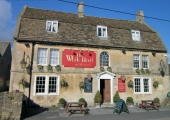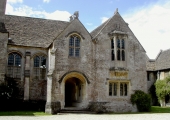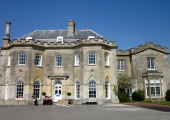.
Atworth
Bradford on Avon Hundred, Wiltshire
.
St Michael’s parish church, Atworth
.
Most of the present parish of Atworth was originally part of the Manor and of the Ancient Parish and a Tithing of the Hundred of Bradford on Avon. It was named as a point on the bounds of the estate of Bradford in the charter of the grant of Bradford to the Abbey of Shaftesbury in 1001. It was not mentioned in the Domesday Book of 1086 because of being part of Bradford. Its church of St Michael was formerly a chapel of the mother church of Holy Trinity in Bradford.
It was also known as Atworth Magna to distinguish it from a smaller area which was called Atworth Parva, Little Atworth or Cottles. The modern Civil Parish of Atworth was created on 19 December 1884 by detaching the Tithing of Atworth from Bradford and combining it with the minor areas of Cottles, Little Chalfield and Great Chalfield.
Etymology
The name has been rendered as versions of Atford and Atworth until settling down as the latter in the late 19th century. The name may refer to the farmstead of a Saxon called Ætta or may simply derive from Old English aet -meaning oats. There is no significant ford here.
The site
Atworth lies in undulating country on the Forest Marble clays, Cornbrash limestones and Kellaways Beds, rising towards the hills of the north and west. The parish is bounded on the north from Corsham by a straight border that follows the east-west line of the old Roman road from Londinium to Aquae Sulis (Bath); in the east are Broughton Gifford and Shaw in Melksham Without, to the south is Holt, to the west is South Wraxall.
The Settlement
The village of Atworth consists of two parts- an old nuclear settlement near the church and a long narrow strip along the turnpike Bath Road (A365 Melksham to Box), which was for a while the main road from London to Bath. A large amount of recent house-building has now rather blurred the distinction.
The old original village centre contains the Church, Church Farm with a medieval barn, Manor House, former Foresters and Three Horsehoes pubs, primary school, Congregational Chapel and the big C18 Poplar Farm.
The roadside development has the White Hart Inn, the former New Inn and Red Lion Inn, Independent and old Ebenezer Chapels and formerly several shops and small farms. The Bear Garage (with a shop and post office) is on the north western fringe and beyond that is the Neston Farm Shop & Kitchen at Denley Farm, run as a sister to Hartley Farm in Winsley. A clock tower commemorates Queen Victoria’s Diamond Jubilee in 1897 and doubles as the village war memorial.
At the eastern end of the main road was Atworth Common, which was divided into allotments, but is now built over. South of the road at this end was the Mendip engineering company which became part of the Dowty company; it closed in 1991 and the land has been redeveloped.
There are several outlying farms as well.
Employment was once dominated by agriculture, the Neston Park estate (the house and most of the estate are in Corsham parish), stone quarrying north of the village and in Box and Corsham and by the Dowty engineering works. Now the village is largely a dormitory for workers in Bath, Melksham, Corsham, Chippenham and beyond. Today, Atworth Business Park, on the site of the Dowty factory, contains electronics company Interconics Ltd and Leafield Marine Ltd, manufacturers of valves for inflatable boats and marine safety. The proximity and easy road communication means Atworth now looks to Melksham more than its old ties to Bradford.
Cottles, or Atworth Parva, is a rectangular area in the west, in which the only major features are Cottles House, currently occupied by Stonar School, a private school for girls and the Botanic Nursery. It is not clear whether this small area was a part of the Manor of Bradford that was given to Shaftesbury Abbey in 1001, but a narrow strip north of Cottles House was part of Bradford parish.
Great and Little Chalfield are small settlements in the south of the modern parish, once independent and centred around their respective manor houses.
The 2001 Census recorded the population of Atworth at 1,280 inhabitants, rising to 1,321 in 2011.
.
Bradford on Avon Museum has very few objects from Atworth. Excavated material from the Atworth Roman villa is in the Wiltshire Museum at Devizes, where some objects, including stone columns, are displayed in the Roman Gallery.
There is an Atworth History Society which has a collection of memorabilia from the village, viewable on the last Sunday of the month, March to October, 14.00 to 16.00.
Atworth Wiltshire history





